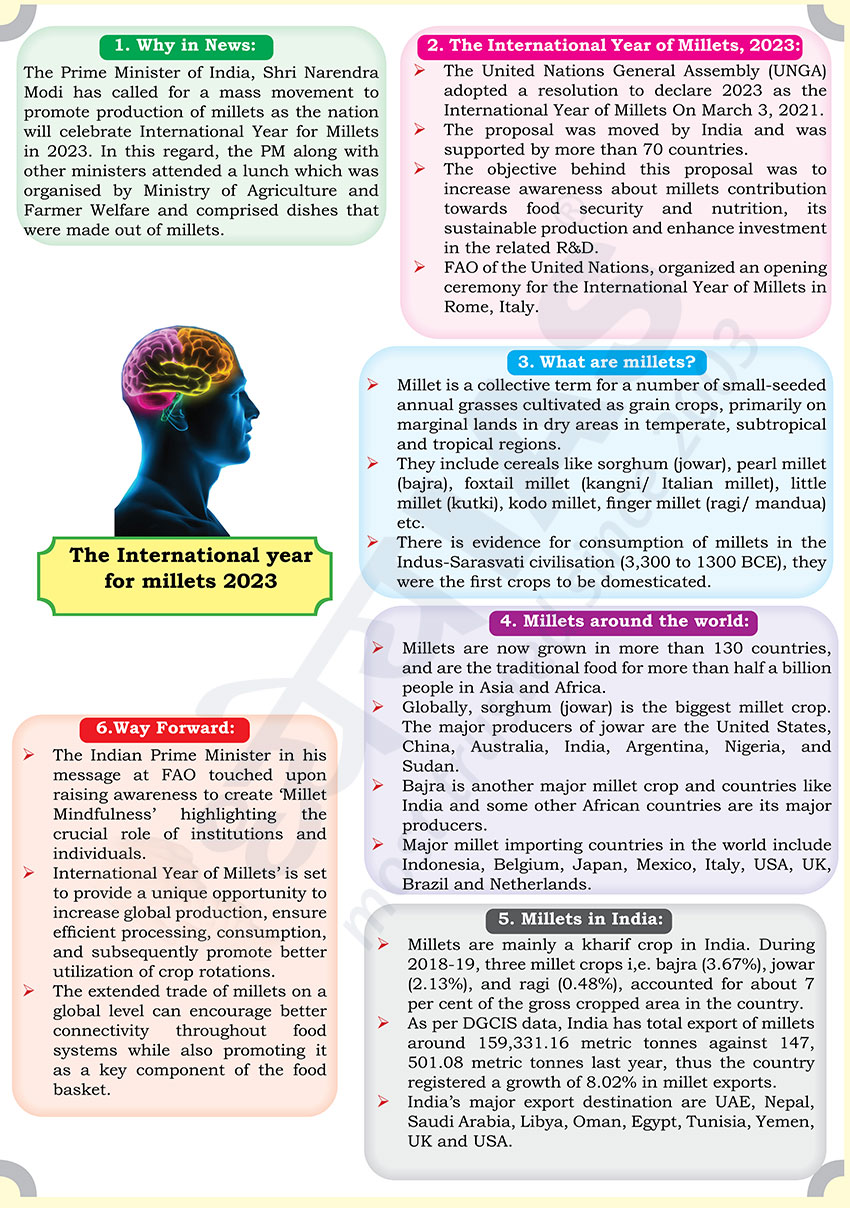Brain-booster
/
09 Jan 2023
Brain Booster for UPSC & State PCS Examination (Topic: The International year for millets 2023)

Why in News?
- The Prime Minister of India, Shri Narendra Modi has called for a mass
movement to promote production of millets as the nation will celebrate
International Year for Millets in 2023. In this regard, the PM along with
other ministers attended a lunch which was organised by Ministry of
Agriculture and Farmer Welfare and comprised dishes that were made out of
millets.
The International Year of Millets, 2023:
- The United Nations General Assembly (UNGA) adopted a resolution to
declare 2023 as the International Year of Millets On March 3, 2021.
- The proposal was moved by India and was supported by more than 70
countries.
- The objective behind this proposal was to increase awareness about
millets contribution towards food security and nutrition, its sustainable
production and enhance investment in the related R&D.
- FAO of the United Nations, organized an opening ceremony for the
International Year of Millets in Rome, Italy.
What are millets?
- Millet is a collective term for a number of small-seeded annual grasses
cultivated as grain crops, primarily on marginal lands in dry areas in
temperate, subtropical and tropical regions.
- They include cereals like sorghum (jowar), pearl millet (bajra), foxtail
millet (kangni/ Italian millet), little millet (kutki), kodo millet, finger
millet (ragi/ mandua) etc.
- There is evidence for consumption of millets in the Indus-Sarasvati
civilisation (3,300 to 1300 BCE), they were the first crops to be
domesticated.
Millets around the world:
- Millets are now grown in more than 130 countries, and are the
traditional food for more than half a billion people in Asia and Africa.
- Globally, sorghum (jowar) is the biggest millet crop. The major
producers of jowar are the United States, China, Australia, India,
Argentina, Nigeria, and Sudan.
- Bajra is another major millet crop and countries like India and some
other African countries are its major producers.
- Major millet importing countries in the world include Indonesia,
Belgium, Japan, Mexico, Italy, USA, UK, Brazil and Netherlands.
Millets in India:
- Millets are mainly a kharif crop in India. During 2018-19, three millet
crops i,e. bajra (3.67%), jowar (2.13%), and ragi (0.48%), accounted for
about 7 per cent of the gross cropped area in the country.
- As per DGCIS data, India has total export of millets around 159,331.16
metric tonnes against 147, 501.08 metric tonnes last year, thus the country
registered a growth of 8.02% in millet exports.
- India’s major export destination are UAE, Nepal, Saudi Arabia, Libya,
Oman, Egypt, Tunisia, Yemen, UK and USA.
Way Forward:
- The Indian Prime Minister in his message at FAO touched upon raising
awareness to create ‘Millet Mindfulness’ highlighting the crucial role of
institutions and individuals.
- International Year of Millets’ is set to provide a unique opportunity to
increase global production, ensure efficient processing, consumption, and
subsequently promote better utilization of crop rotations.
- The extended trade of millets on a global level can encourage better
connectivity throughout food systems while also promoting it as a key
component of the food basket.







